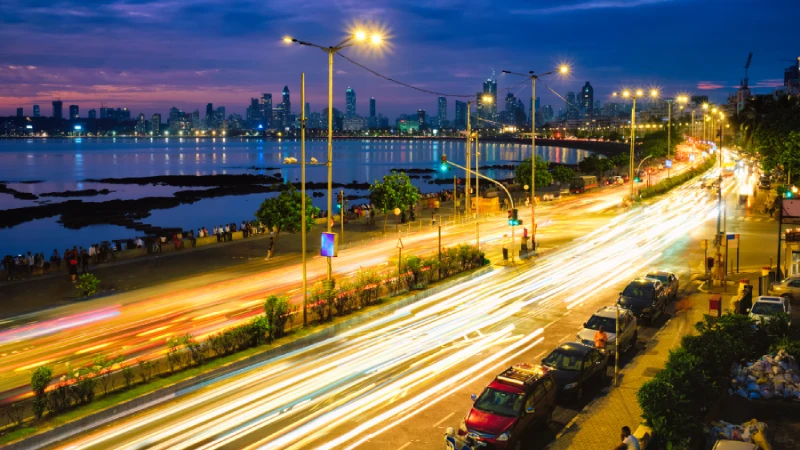Mumbai, the city of dreams, is a bustling metropolis with a transportation network that’s as diverse as its culture. From local trains to auto-rickshaws, the city offers a variety of options to help you navigate its busy streets. Whether you’re a first-time visitor or a seasoned traveler, this Mumbai transportation guide will help you get around the city like a pro. Let’s dive in!
1. Local Trains: The Lifeline of Mumbai
Overview
The Mumbai Local Train network is the backbone of the city’s transportation system. It’s one of the fastest and most affordable ways to travel across Mumbai.
Key Routes
- Western Line: Connects Churchgate to Dahanu Road (via Andheri, Bandra, and Borivali).
- Central Line: Connects Chhatrapati Shivaji Maharaj Terminus (CSMT) to Kasara/Karjat (via Dadar, Kurla, and Thane).
- Harbour Line: Connects CSMT to Panvel (via Wadala and Chembur).
Tips for Traveling by Local Train
- Peak Hours: Avoid traveling during rush hours (8-10 AM and 6-8 PM) as trains can get extremely crowded.
- Ladies’ Compartment: Women can travel in designated ladies’ compartments for added safety and comfort.
- First-Class vs. Second-Class: First-class tickets are more expensive but less crowded. Second-class is cheaper but can be packed.
Fares
- Second-Class: ₹10-₹50 (depending on distance).
- First-Class: ₹80-₹200 (depending on distance).
2. BEST Buses: Affordable and Extensive
Overview
The Brihanmumbai Electric Supply and Transport (BEST) bus network covers almost every part of the city. It’s a great option for short distances and areas not served by local trains.
Types of Buses
- Regular Buses: Standard buses that cover most routes.
- AC Buses: Air-conditioned buses for a more comfortable ride.
- Electric Buses: Eco-friendly buses introduced in recent years.
Tips for Traveling by BEST Buses
- Bus Stops: Look for BEST bus stops, which are marked with a red and white sign.
- Change: Carry small change as conductors may not have change for large bills.
- Mobile App: Use the BEST Pravas app to check bus routes and timings.
Fares
- Non-AC Buses: ₹5-₹25 (depending on distance).
- AC Buses: ₹20-₹50 (depending on distance).
3. Auto-Rickshaws and Taxis: Convenient for Short Distances
Overview
Auto-rickshaws and black-and-yellow taxis are a convenient way to travel short distances in Mumbai. They’re easily available and can navigate through narrow lanes.
Tips for Traveling by Auto-Rickshaws and Taxis
- Metered Fare: Always insist on using the meter. Auto-rickshaws and taxis are required by law to use meters.
- Shared Rides: In some areas, you can share auto-rickshaws with other passengers to save money.
- Ride-Hailing Apps: Use apps like Uber and Ola for a hassle-free experience.
Fares
- Auto-Rickshaws: ₹25 (minimum fare) + ₹18 per kilometer.
- Taxis: ₹25 (minimum fare) + ₹24 per kilometer.
4. Mumbai Metro: Modern and Efficient
Overview
The Mumbai Metro is a modern and efficient way to travel across the city. Currently, Line 1 (Versova-Andheri-Ghatkopar) is operational, with more lines under construction.
Key Stations
- Versova: Connects to Andheri and Ghatkopar.
- Ghatkopar: Connects to the Central Line and Eastern Suburbs.
Tips for Traveling by Metro
- Smart Cards: Use a Mumbai Metro Smart Card for discounted fares and faster entry.
- Frequency: Trains run every 4-5 minutes during peak hours.
- Accessibility: Metro stations are equipped with elevators and escalators for easy access.
Fares
- Single Journey: ₹10-₹40 (depending on distance).
- Smart Card: Offers a 10% discount on fares.
5. Monorail: Scenic and Unique
Overview
The Mumbai Monorail is a unique mode of transportation that offers scenic views of the city. It connects Chembur to Sant Gadge Maharaj Chowk (near Jacob Circle).
Tips for Traveling by Monorail
- Frequency: Trains run every 15-20 minutes.
- Views: Sit by the window for stunning views of the city.
- Connections: The monorail connects to the Central Line at Chembur.
Fares
- Single Journey: ₹10-₹40 (depending on distance).
6. Ferries: A Scenic Way to Travel
Overview
Mumbai’s ferry services are a scenic way to travel, especially to destinations like Elephanta Island and Mandwa.
Key Routes
- Gateway of India to Elephanta Caves: A popular route for tourists.
- Gateway of India to Mandwa: A quicker alternative to reach Alibaug.
Tips for Traveling by Ferry
- Timings: Check ferry timings in advance, especially for the last ferry back.
- Tickets: Buy tickets at the ferry terminal or online.
- Weather: Avoid ferry rides during monsoon due to rough seas.
Fares
- Elephanta Caves: ₹200-₹250 (round trip).
- Mandwa: ₹150-₹200 (one way).
7. App-Based Cabs: Convenient and Reliable
Overview
App-based cab services like Uber and Ola are a convenient and reliable way to get around Mumbai. They offer a range of options, from budget to luxury.
Tips for Traveling by App-Based Cabs
- Surge Pricing: Be aware of surge pricing during peak hours or bad weather.
- Safety: Share your ride details with someone for added safety.
- Payment: Use cashless payment options for a hassle-free experience.
Fares
- Uber Go/Ola Mini: ₹10-₹15 per kilometer.
- Uber Premier/Ola Sedan: ₹15-₹20 per kilometer.
8. Walking and Cycling: Explore at Your Own Pace
Overview
Walking and cycling are great ways to explore Mumbai’s neighborhoods, especially in areas like Colaba, Bandra, and Fort.
Tips for Walking and Cycling
- Safety: Stick to pedestrian-friendly areas and avoid walking alone at night.
- Cycling Routes: Use dedicated cycling lanes in areas like Marine Drive and Bandra Kurla Complex (BKC).
- Rentals: Use cycle rental services like SmartBike for short rides.
Conclusion
Navigating Mumbai’s transportation system can seem overwhelming at first, but with this guide, you’ll be able to get around the city like a local. Whether you’re hopping on a local train, taking a BEST bus, or enjoying a scenic ferry ride, Mumbai offers a variety of options to suit every traveler’s needs. So, pack your bags, plan your route, and get ready to explore the city of dreams!

